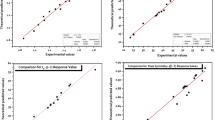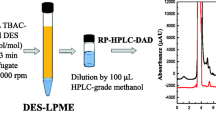Abstract
This article presents the first application of fully automated three-dimensional (3D) column-switching SPE–FIA–HPLC system for the characterization of lipids by a single injection. The whole system was designed and set up by modifying Agilent 1200 Series HPLC system in our laboratory. By using this system, a complete separation profile of the oil samples was achieved in a very short time period by using single injections. This approach was applied on vegetable oils which contains a large number of relatively high-class lipid components, such as TG, FFA, sterols, tocopherols, DG, ester and MG. In this part of the study, we focused on the optimization of evaporative light scattering detector (ELSD) by using an experimental design and RSM. Three experimental parameters were chosen as an independent variables which are the flow rate of mobile phase, nebulization temperature and evaporation temperature. A multivariate five level experimental design was used to establish a quadratic model as a functional relationship between the response values and independent variables. The optimal values of parameters were found to be a flow rate of 1.25 mL min−1, nebulization temperature of 80 °C, and evaporation temperature of 40 °C. Regression analysis with an R 2 values indicated as a satisfactory correlation between the experimental and predicted values. ANOVA test results were also illustrate that the models can be successfully used to predict the optimum parameters of ELSD. Thus, the proposed system is suitable for a large number of applications including research and development of new quality control and characterization methods for vegetable oils.






Similar content being viewed by others
Abbreviations
- ANOVA:
-
Analysis of variance
- ELSD:
-
Evaporative light scattering detector
- FIA:
-
Flow injection analysis
- HPLC:
-
High performance liquid chromatography
- NLs:
-
Neutral lipids
- PLs:
-
Polar lipids
- RSM:
-
Response surface methodology
- S/N ratio:
-
Signal to noise ratio
- SPE:
-
Solid phase extraction
- 3D:
-
Three-dimensional
- 2D:
-
Two-dimensional
- 1st-D:
-
First-dimensional
- 2nd-D:
-
Second-dimensional
- 3rd-D:
-
Third-dimensional
References
Cigic T, Blaz P, Vidrih R, Ulrih NP, Segatin N (2013) Correlation of basic oil quality indices and electrical properties of model vegetable oil systems. J Agric Food Chem 61:11355–11362
Ruiz-Gutierrez V, Perez-Camino MC (2000) Update on solid-phase extraction for the analysis of lipid classes and related compounds. J Chromatogr A 885:321–341
Karantonis HC, Antonopoulou S, Demopoulos CA (2002) Antithrombotic lipid minor constituents from vegetable oils comparison between olive oils and others. J Agric Food Chem 50:1150–1160
Kaufman M, Wiesman Z (2007) Pomegranate oil analysis with emphasis on MALDI-TOF/MS triacylglycerol fingerprinting. J Agric Food Chem 55:10405–10413
Nordback J, Lundberg E, Christie WW (1998) Separation of lipid classes from marine particulate material by HPLC on a polyvinyl alcohol-bonded stationary phase using dual-channel evaporative light-scattering detection. Mar Chem 60:165–175
Lee WJ, Su NW, Lee MH, Lin JT (2013) Assessment of authenticity of sesame oil by modified Villavecchia test and HPLC-ELSD analysis of triacylglycerol profile. Food Res Int 53:195–202
Compton D, Laszlo JA, Berhow MA (2006) Identification and quantification of feruloylated mono-, di-, and triacylglycerols from vegetable oils. J Am Oil Chem Soc 83:753–758
Amaral JS, Cunha SC, Alves MR, Pereira JA, Seabra RM, Oliveira BPP (2004) Triacylglycerol composition of walnut (Juglans regia L.) cultivars: characterization by HPLC-ELSD and chemometrics. J Agric Food Chem 52:7964–7969
Le TT, Miocinovic J, Nguyen TM, Rombaut R, Camp J, Dewettinck K (2011) Improved solvent extraction procedure and high-performance liquid chromatography evaporative light-scattering detector method for analysis of polar lipids from dairy materials. J Agric Food Chem 59:10407–10413
Torres CF, Vazquez L, Senorans FJ, Reglero G (2005) Study of the analysis of alkoxyglycerols and other non-polar lipids by liquid chromatography coupled with evaporative light scattering detector. J Chromatogr A 1078:28–34
Homan R, Anderson MK (1998) Rapid separation and quantitation of combined neutral and polar lipid classes by high-performance liquid chromatography and evaporative light-scattering mass detection. J Chromatogr B 708:21–26
Silversand C, Haux C (1997) Improved high-performance liquid chromatographic method for the separation and quantification of lipid classes: application to fish lipids. J Chromatogr B 703:7–14
Foglia TA, Jones KC (1997) Quantitation of neutral lipid mixtures using high performance liquid chromatography with light scattering detection. J Liq Chromatogr Relat Technol 20:1829–1838
Bravi E, Perretti G, Montanari L (2006) Fatty acids by high-performance liquid chromatography and evaporative light-scattering detector. J Chromatogr A 1134:210–214
Megoulas NC, Koupparis MA (2005) Twenty years of evaporative light scattering detection. Crit Rev Anal Chem 35:301–316
Zhao J, Li SP, Yanga FQ, Li P, Wang YT (2006) Simultaneous determination of saponins and fatty acids in Ziziphus jujuba (Suanzaoren) by high performance liquid chromatography-evaporative light scattering detection and pressurized liquid extraction. J Chromatogr A 1108:188–194
Klift EJC, Truyols GV, Claassen FW, Holthoon FL, Beek TA (2008) Comprehensive two-dimensional liquid chromatography with ultraviolet, evaporative light scattering and mass spectrometric detection of triacylglycerols in corn oil. J Chromatogr A 1178:43–55
Mondello L, Beccaria M, Donato P, Cacciola F, Dugo G, Dugo P (2011) Comprehensive two-dimensional liquid chromatography with evaporative light scattering detection for the analysis of triacylglycerols in Borago officinalis. J Sep Sci 34:688–692
Jandera P (2012) Comprehensive two-dimensional liquid chromatography—practical impacts of theoretical considerations. A review. Cent Eur J Chem 10(3):844–875
Baeten V, Meurens M (1996) Detection of virgin olive oil adulteration by Fourier transform Raman spectroscopy. J Agric Food Chem 44:2225–2230
Rodríguez-Alcalá LM, Fontecha J (2010) Major lipid classes separation of buttermilk, and cows, goats and ewes milk by high performance liquid chromatography with an evaporative light scattering detector focused on the phospholipid fraction. J Chromatogr A 1217:3063–3066
Lundstedt T, Seifert E, Abramo L, Thelin B, Nyström Å, Pettersen J, Bergman R (1998) Experimental design and optimization. Chemometr Intell Lab Syst 42:3–40
Brereton RG (1997) Multilevel multifactor designs for multivariate calibration. Analyst 122:1521–1529
Memon FN, Ayyilidiz F, Kara H, Memon S, Kenar A, Topkafa M, Sherazi STH, Memon NA, Durmaz F, Tarhan I (2015) Application of central composite design for the optimization of on-line solid phase extraction of Cu2+ by calix[4]arene bonded silica resin. Chemometr Intell Lab Syst 146:158–168
Navarrete-Bolanos JL, Jimnez-Islas H, Botello-Alvarez E, Rico-Martınez R (2002) Application of the response surface methodology for the design of a lixiviation process. Org Process Res Dev 6:841–846
Van Nederkassel AM, Vijverman V, Massart DL, Vander Heyden Y (2005) Development of a Ginkgo biloba fingerprint chromatogram with UV and evaporative light scattering detection and optimization of the evaporative light scattering detector operating conditions. J Chromatogr A 1085:230–239
Karatapanis AE, Fiamegos YC, Sakkas VA, Stalikas CD (2011) Effect of chromatographic parameters and detector settings on the response of HILIC–evaporative light-scattering detection system using experimental design approach and multicriteria optimization methodology. Talanta 83:1126–1133
Coleman J, Wrzosek T, Roman R, Peterson J, McAllister P (2001) Setting system suitability criteria for delectability in high-performance liquid chromatography methods using signal-to-noise ratio statistical tolerance intervals. J Chromatogr A 917:23–27
McLaren DG, Miller PL, Lassman ME, Castro-Perez JM, Hubbard BK, Roddy TP (2011) An ultraperformance liquid chromatography method for the normal-phase separation of lipids. Anal Biochem 414(2):266–272
Acknowledgments
The present study is a part of the Ph.D. thesis entitled “Integration of retarded and pre-concentrated SPE systems to FIA-HPLC systems for vegetable oil analysis and improvement of its applications”. The research was supported by TUBITAK with a 1001-The Support Program for Scientific and Technological Research Projects entitled “Developing a new SPE–FIA–HPLC hyphenated system for three-dimensional chromatographic analysis of vegetable oils with a single injection and their applications” with 112T373 Project number and Selcuk University Coordinators of Scientific Research with 12401045 and 11201063 Project numbers. The authors wish to thank the principal of TUBITAK and Selcuk University S.R.P. Coordination.
Author information
Authors and Affiliations
Corresponding author
Ethics declarations
Conflict of interest
The authors declare that they have no conflict of interest.
About this article
Cite this article
Arslan, F.N., Kara, H. Fully Automated Three-Dimensional Column-Switching SPE–FIA–HPLC System for the Characterization of Lipids by a Single Injection: Part I. Instrumental Design and Chemometric Approach to Assess the Effect of Experimental Settings on the Response of ELSD. J Am Oil Chem Soc 93, 11–26 (2016). https://doi.org/10.1007/s11746-015-2750-0
Received:
Revised:
Accepted:
Published:
Issue Date:
DOI: https://doi.org/10.1007/s11746-015-2750-0




